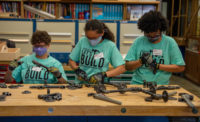
|
| Anna J. Molberg |
Many engineering and construction companies are experiencing a shortage of qualified workers. Firms frequently find that their top candidates need a work authorization to be employed in the U.S. The most common work visa is the H-1B, designed for individuals with at least a four-year college degree working in a specialty occupation for a U.S. employer.
Obtaining an H-1B visa is not as simple as merely applying. The U.S. Citizenship and Immigration Services (USCIS) limits visas to 85,000 each year, available on April 1. Out of that number, or cap, 20,000 visas are reserved for individuals with a master’s degree or higher. In recent years, USCIS has received more applications than visas, including 172,500 applications in 2014 and 233,000 applications in 2015. When USCIS receives more applications than available visas, it holds a lottery to choose the applicants. The lottery does not apply to individuals already approved and working in an H-1B status.
Employers need to prepare their H-1B petitions well before the April 1 filing date. Companies should first ensure that they are registered with the Dept. of Labor (DOL) to file an H-1B and then submit a labor condition application (LCA) stating that the employer will pay the H-1B worker what a U.S. worker with the same experience and education would be paid. The LCA will be approved, or certified, by the DOL within seven days.
The final H-1B petition must include the certified LCA, the application, an employer-support letter and evidence that the foreign national has a four-year degree or its equivalent, in addition to immigration documents or other qualifications. The petition must also include the government filing fees, which vary depending upon the size of the company.
Employers should be cautious with certain aspects of H-1B petitions. The position must be a specialty occupation that requires a college degree for the work that will be done. Firms can file an H-1B for a worker already in the U.S. or for one who is outside the country. Employees outside of the U.S. will need to take their H-1B approval notice to a U.S. consulate to get an H-1B visa stamp before they enter the country and start work. Employers should never submit more than one H-1B application for an employee as a way to improve the odds of winning the H-1B lottery. If USCIS finds that more than one petition has been filed, it will deny all duplicative applications. However, foreign nationals may have multiple H-1B petitions filed on their behalf by different companies.
Employers must heed the H-1B time line. USCIS should receive petitions on April 1, not before or after that date. If an H-1B visa application is accepted and approved, the earliest date the employee can begin work is Oct. 1.
If potential foreign national employees are working in OPT status (work authorization pursuant to student status) when the H-1B is filed and their H-1B petitions are accepted into the lottery, the worker’s OPT work authorization is automatically extended until the H-1B’s Oct. 1 start date. Some H-1B applications may receive a request for evidence, asking the employer to submit more information by a specified deadline.
The H-1B is valid for six years, but the initial application will be approved for less than six years. Employers need to carefully monitor employees’ H-1B expiration dates to ensure that extensions are filed on time. An H-1B employee must be paid the wage stated in the petition, with evidence of that pay rate submitted for an extension to be approved.
H-1B workers can transfer their petition to another employer. If employers want to file a green card application for their employee, they should start the process by the employee’s fourth year of H-1B status.
Employers must maintain a public access file of H-1B documentation in the event of a DOL audit. Employers also need to notify USCIS of any substantial changes in the H-1B employee’s working conditions or location. USCIS will occasionally conduct site visits, and employers should have documents on hand to demonstrate H-1B compliance.
If an H-1B petition is done properly, it can be a great tool to add qualified workers to a business—as long as the employer is lucky enough to win the initial H-1B lottery.




Post a comment to this article
Report Abusive Comment